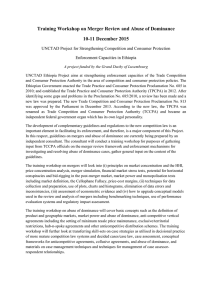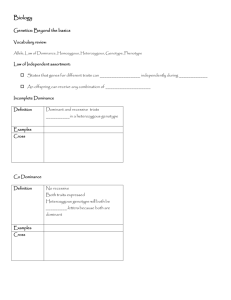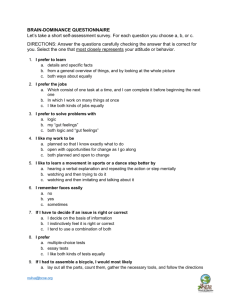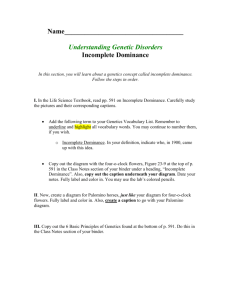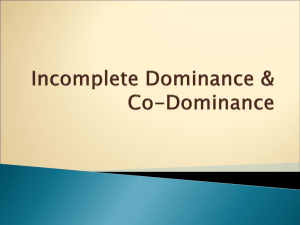Recent developments in Hungarian merger control
advertisement
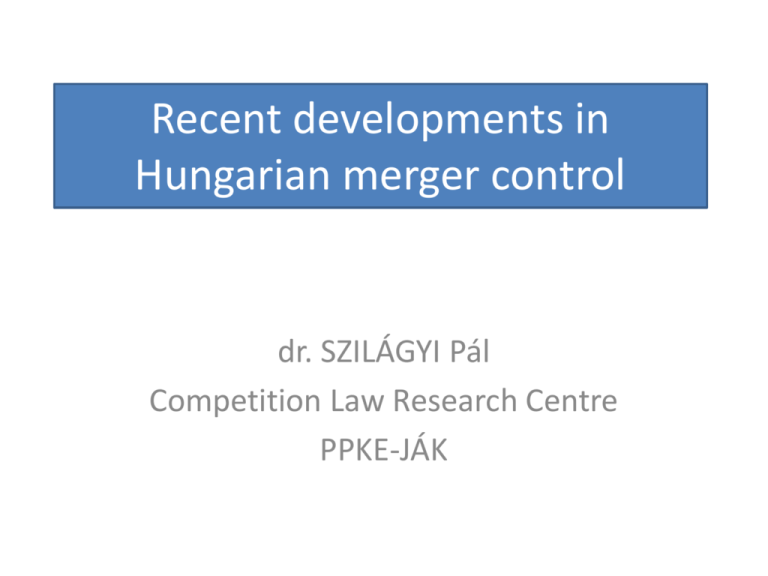
Recent developments in Hungarian merger control dr. SZILÁGYI Pál Competition Law Research Centre PPKE-JÁK Changes in European Merger Control • • • • Change in 2004 Filling in the ‘GAP’ Q: was there a ‘GAP’? In theory there was a ‘GAP’ • In practice questionable • Cf. presentation of Ioannis Kokkoris: YES Legislative changes in Hungary (2009) • Until 2009: dominance test; from 1 June 2009: new test • New test in the HCO : significant reduction of competition + dominance • New test according to the official interpretation by the legislator: SLC-test . Art. 30 (2) HCO: “The Hungarian Competition Authority may not refuse to grant authorisation for a concentration where, with a view to the [advantages and disadvantages], the concentration would not significantly reduce competition on the relevant market [...], in particular as a result of the creation or strengthening of a dominant position.” (official translation by the authority) Legislative changes in Hungary (2009) cont. • NB: the legislator equals SLC to SIEC in theory, but it explains the change in the following words: „The SLC test compared to the dominance test allows to prohibit concentrations which do not create (strengthen) a dominant position if they significantly reduce competition, while on the other side allows to clear concentrations which create (strengthen) a dominant position if this is counterbalanced by efficiency gains.” • But Cf. Recital (25) Reg. 139/2004! Case study 1: HTCC/Matel (Vj-19/2007) • Concentration between two telecom companies • On the Internet- and data-communication services market: Undertaking 2004 2005 2006 2006 (combined) Telecom group 40-60 40-60 40-60 40-60 Matel 10-20 10-20 10-20 HTCC 10-20 10-20 10-20 GTS-Datanet 5-15 5-15 5-15 5-15 Other providers 15-20 15-20 15-20 15-20 25-30 Not included in the decision, but can be found in other sources. E.g. Csorba, Gergely: A fúziókontroll módszertanáról. Dominancia- vagy versenyhatásteszt? In Valentiny és Kiss: Verseny és szabályozás 2007. (MTA Közgazdaságtudományi Intézet, Budapest, 2008) Case study 1: HTCC/Matel (Vj-19/2007) – cont. • The concentration combines the second and third player • HHI raises to more 2500 with a change of 300-400 (source: Csorba op.cit.) • Bidding study: HTCC and Matel express only a limited pressure on each other; GTS-Datanet exerts stronger pressure • Not a merger of the closest competitors. • No SLC, no dominance. • Allowed Case study 2: Hungarian Telekom/ViDaNet (Vj-158/2008) • Full acquisition of ViDaNet by HT • Battle over the issue: is mobilenet in the same market as broadband DSL? • Bottleneck of the case: Internet service providing • Market shares rise to 55-70%. • The two companies are the owners of the networks and no entry is expected. • Creation or strengthening of a dominant position: prohibited Case study 3: Ringier/Híd (Vj-155/2008) • Full acquisition of Híd by Ringier: two sided markets; tabloids. • Market shares (sale; advertising revenues on the nationwide tabloid market): 2005 2006 2007 2008 Blikk (Ringier) 86,7 73,8 73,2 72,3 Bors (Híd) 13,3 19,1 21,2 23,2 Napi Ász - 7,1 5,6 4,5 100 100 100 100 SUM: 2006 2007 Blikk (Ringier) 80-90 80-90 Bors (Híd) 10-15 10-15 SUM: 95-100 95-100 2008 (SUM) 95,4 Case study 3: Ringier/Híd (Vj-155/2008) • Merger of the first and second player • Extremely high market shares • In principle this could also be allowed (!) if there is entry. • Weighting of pros and cons by the GVH (under the dominance test!): „the creation or strengthening of dominant position does not automatically lead to the conclusion that the concentration has to be prohibited”. • Notification withdrawn. Sophisticated economic analysis • • • • Customer and consumer surveys Large sample questionnaires Regression analysis Bidding studies • It is clear that sophisticated economic analysis is not only present in SIEC/SLC test, but also under dominance. Statistics 2005 2006 2007 2008 2009 All merger cases 70 43 46 37 42 No concerns („Phase I”) 59 33 39 34 NA Concerns („Phase II”) 11 10 7 2 NA Cleared 58 35 36 28 NA Cleared with conditions 1 3 3 2 NA Prohibited 0 0 0 0 2 Questions Hungary has a small-medium sized traditionally open market. Questions which have to be answered in light of experience: -Is it justified to spend valuable resources of both the market players and the authority on real or imagined GAP cases in such an economy? - Or is a clear cut dominance test more suitable?


